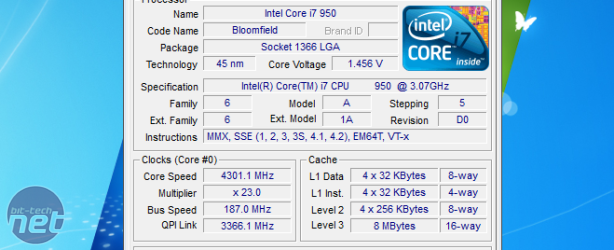Performance Analysis
The i7-950's extra clock speed looks great on paper but means nothing if it doesn't lead to any real world benefits. Fortunately our Media Benchmark suite sorts the men from the boys and we saw an appreciable difference between the i7-950 and the doomed i7-930.At out of the box speeds the i7-950 was 9 per cent faster in our image editing test and 7 per cent faster in our multi-threaded video encoding test. These results aren't anything spectacular but are in line with the 8 per cent price premium the i7-950 carries over the i7-930. We saw less difference in our stock speed multi-tasking test however, as this is less dependent on raw CPU speeds. These results added up to an overall stock speed score of 1,762 for the i7-950 compared to the 1,674 of its lower clocked sibling.
Things changed around when the two chips were overclocked though as the lower QPI and memory speed of the i7-950 hampered it badly in the multi-tasking portion of the suite. This meant the i7-950 fell some 133 points behind the i7-930 overall.
Cinebench R10 relies solely on frequency so we saw a large difference of just over 2,000 points between the two CPUs when both were at their factory settings. If you're looking to do a lot of 3D rendering, raw clock speed is your friend. Puzzlingly, at stock speed WPrime favoured the i7-930 over the i7-950, despite the technical superiority of the latter. The i7-930 drew level with the i7-950 in Cinebench when both chips were overclocked, though this is hardly surprising giving that they were running at the same speed.
You'd be hard pressed to tell the difference between the two chips if the primary use for your PC was gaming though, as they returned nearly identical results in Crysis. The i7-950 was ahead by a whisker but you'd probably have to drink eight cans of Red Bull to be able to actually be able to notice this. The polygon-heavy X3: Terran Conflict gave slightly more of an advantage to the i7-950 though, but again you'd have to be superhuman to tell the difference between minimums of 88fps and 95fps.
We saw the same trend as in the rest of our tests when the two chips were overclocked. The 4.3GHz i7-930 managed to nose ahead of the identically clocked but i7-950 in both Crysis and X3: Terran Conflict. Again the differences were only minute but its interesting to see that the way in which you overclock your CPU (i.e. with the QPI or with the multiplier) can have a quantifiable bearing on its performance
Conclusion
We're struggling to draw a firm conclusion about the Core i7-950. It's a fraction more expensive than the i7-930 and a fraction quicker in real world tasks; you're basically getting exactly what you're paying for. We had problems overclocking our i7-950 - the slightly high 1.2V vid might have had something to do with this - but as we always say with overclocking, your mileage may vary. It's entirely possible we got a poor chip and even if we did, then an easy 4GHz overclock isn't to be sniffed at.While the LGA1366 range is due to continue well into next year, we can't help but be suspicious: rumours are that Intel slashed its price to shift stock before Sandy Bridge performance figures became available. That being said, the i7-950 is available now and it's undeniably quick - you could play the waiting game forever when trying to spec out a new PC, after all. With the LGA1156 in a much more dubious position given the impending arrival of Sandy Bridge, the i7-930 and i7-950 are the only high-end quad-core CPUs even worth considering.
- Performance
- x
- x
- x
- x
- x
- x
- x
- x
- x
- -
- 9/10
- Value
- x
- x
- x
- x
- x
- x
- x
- x
- x
- -
- 9/10
- Overall
- x
- x
- x
- x
- x
- x
- x
- x
- x
- -
- 9/10

Intel Core i7-950

MSI MPG Velox 100R Chassis Review
October 14 2021 | 15:04











Want to comment? Please log in.